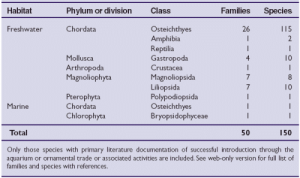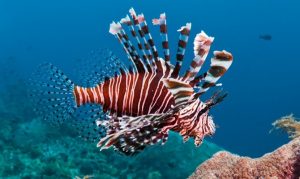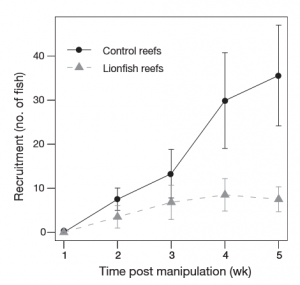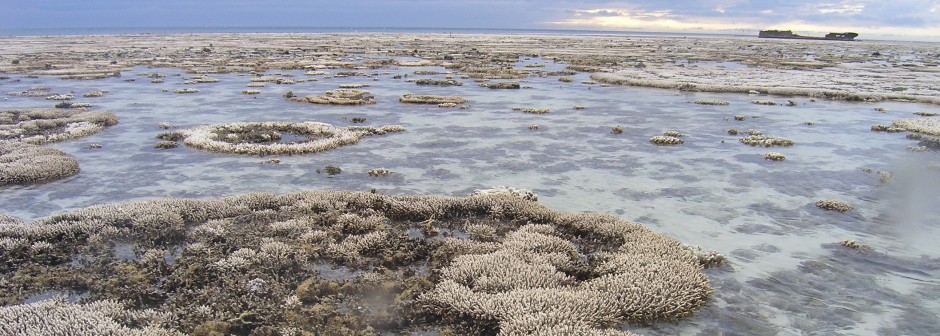Many aquariums boast exhibits of exotic fish from faraway places. While these may seem like harmless attractions behind the glass, these fish don’t always stay behind glass. Oftentimes, these foreign fish are released into local waters, altering their new environment. In my first post, I discussed the history of the aquarium trade and some general effects it has had on coral reefs. Now, I will focus on one of the most significant dangers that the aquarium trade poses to coral reefs: the introduction of invasive species. In fact, aquarium releases make up one third of invasive species globally and are one of the top five avenues for introducing invasive species into the marine environment1.
A large reason why this is an issue is because of the incredible scarcity of regulation in the aquarium industry. There are an estimated 11 million1 aquarium hobbyists in the U.S, and there’s virtually no certain way to control their purchasing actions. For example, despite the fact that water hyacinths (a registered major invasive species) are banned in multiple states, many hobbyists are still able to purchase them through the internet for as little as $41. With the accessibility and anonymity of the internet these days, it’s easy to see how quickly the private aquarium trade can blow out of control. This lack of strict regulation inevitably leads to a large number of releases of invasive species into local waters. To date, there have been an estimated 50 families and 150 species that are registered as invasive species.

Fig. 1: Table of species of registered invasive ornamental aquarium fish species. Source: Padilla et al. (2004).
So what’s the big deal with a couple new fish coming into new waters? In this case, the more is NOT the merrier. A few general threats invasive species pose to coral reef ecosystems include: reduced biodiversity, competition with local species, increased coral erosion, and changing reef topography.
One of the most successful invasive species is the lionfish. Lionfish are most commonly introduced by the aquarium trade, although ballast water can also be a pathway2. The large lionfish presence in the Atlantic is hypothesized to be due to aquarium releases off the coast of Florida in 19923.

A lionfish—an invasive species originally from the Indo-Pacific that now threatens ecosystems in the U.S coast and Atlantic due to aquarium releases. Source: https://sites.psu.edu/siowfa15/2015/10/20/lion-fish/
A study conducted in the Bahamas (Albins et. al (2008)) revealed the drastic detriments lionfish can cause in a short period of time. In this study, scientists paired up twenty reefs (one is control reef, other has lionfish) to compare the short term effects of lionfish on a reef community. The results were both shocking and distressing. Over a 5 week period, the reefs transplanted with lionfish saw a significant decrease in the recruitment of juvenile native fish3. This is particularly troubling because recruitment of juvenile fish is a crucial part of the coral reef ecosystem’s life cycle. If this middle part of reef development is threatened, then the entire reef structure is threatened!

Fig. 2: This graph shows the drastic difference between recruitment of fish on reefs with and without lionfish. Notice how the lionfish reefs exhibit significantly less fish recruitment in only a few weeks. Source: Albins et al. (2008).
Results also showed that lionfish contributed to 79 percent of the depletion of native fishes3. This is due to the lionfish’s unique predation strategy, which entails them cornering prey with their ornate fins and striking aggressively. Lionfish are quite successful invasive predators because native fish are not used to this strategy. Not only that, but the lionfish’s preying prowess puts it in direct completion with local predators, threatening their status in the reef community3.
Some suggested solutions to the invasive species epidemic have been to, first of all, construct a whitelist of safe aquarium species to purchase. You can help by spreading this information and advocating for the purchase of safe species. Let your friends or readers know which species should be off-limits. Education and awareness is the first step in saving our coral reefs!
References
1 Padilla, Dianna K., and Susan L. Williams. “Beyond ballast water: aquarium and ornamental trades as sources of invasive species in aquatic ecosystems.” Frontiers in Ecology and the Environment 2.3 (2004): 131-38. Ecological Society of America. Web. 22 Mar. 2017.
2Whitfield, Paula E. “Biological invasion of the Indo-Pacific lionfish Pterois volitans along the Atlantic coast of North America.” Marine Ecology Progress Series 235 (2002): 289-97. Inter-Research. Web. 22 Mar. 2017. <http://www.int-res.com/abstracts/meps/v235/p289-297>.
3Albins, Mark, and Mark Hixon. “Invasive Indo-Pacific lionfish Pterois volitans reduce recruitment of Atlantic coral-reef fishes.” Marine Ecology Progress Series 367 (2008): 233-38. Inter-Research. Web. 22 Mar. 2017. <http://www.int-res.com/abstracts/meps/v367/p233-238/>.

